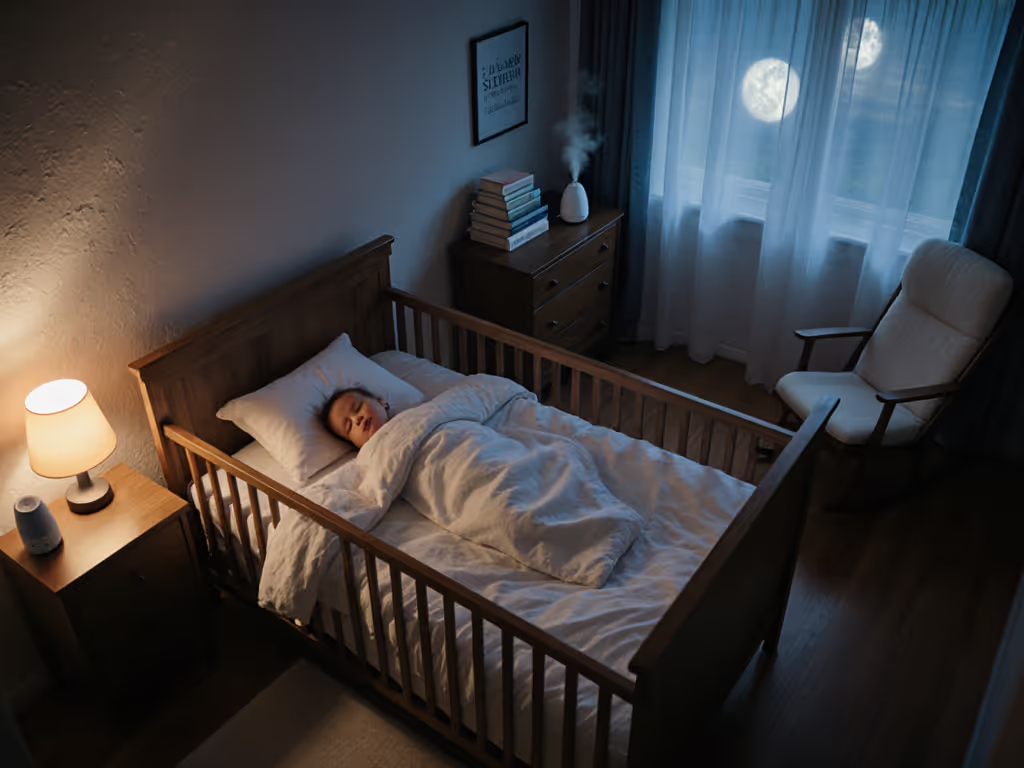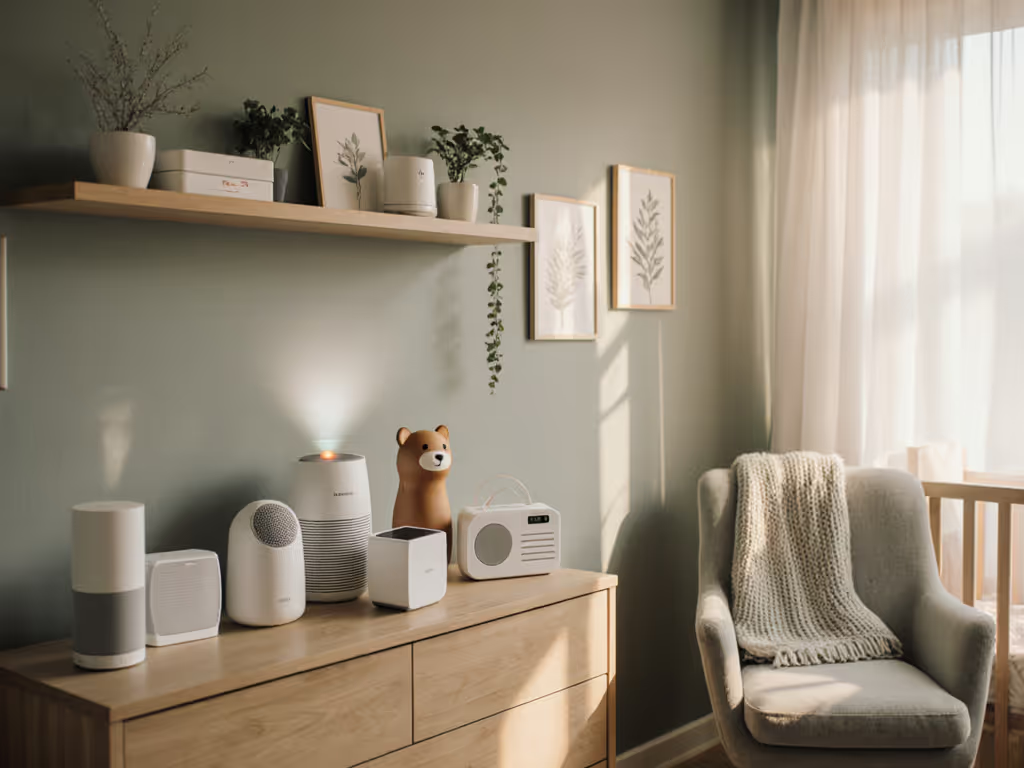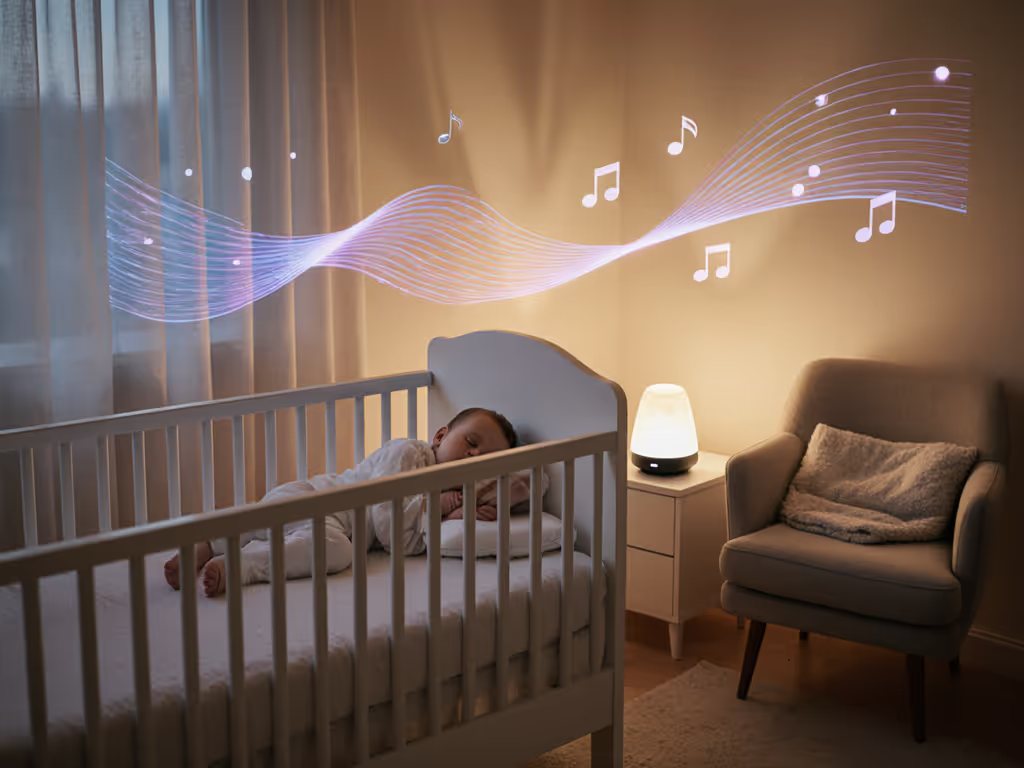
7 Expert Infant Sleep Improvement Tips for Restful Nights

Did you know that babies who follow a regular bedtime routine fall asleep faster and wake less often at night? Quality sleep is essential for a child’s growth and a parent’s peace of mind. Understanding the science of infant sleep can help you create restful nights for your whole family. Discover practical ways to improve your baby’s sleep and safety with small changes that make a big difference.
Quick Summary
| Takeaway | Explanation |
|---|---|
| 1. Establish a consistent bedtime routine. | A predictable routine helps signal bedtime and promotes better sleep patterns for your baby. |
| 2. Create an ideal sleep environment. | Manage sound levels and room temperature to foster peaceful sleep and minimize disruptions. |
| 3. Follow safe sleep practices diligently. | Implementing safe sleep guidelines significantly reduces risks associated with Sudden Infant Death Syndrome (SIDS). |
| 4. Monitor and respond to early sleep cues. | Recognizing subtle signals of sleepiness can prevent overtiredness, improving your baby's sleep experience. |
| 5. Gradually introduce independent sleep skills. | Teach your baby self-soothing methods to help them fall asleep independently over time. |
1. Establish a Consistent Bedtime Routine for Babies
Every parent dreams of peaceful nights and well-rested babies. The secret? A predictable bedtime routine that signals to your little one it is time to wind down and prepare for sleep.
Research has shown remarkable benefits to implementing a consistent nightly ritual. A large multinational study tracking over 10,000 children discovered that babies with regular bedtime routines experienced significant improvements in sleep patterns. These improvements included earlier bedtimes, shorter time falling asleep, and fewer nighttime disruptions.
Creating an effective bedtime routine does not require complex strategies. Instead, focus on simple, repeatable actions that help your baby recognize sleep is approaching. A typical routine might include:
- Giving a warm bath
- Changing into comfortable pajamas
- Reading a short bedtime story
- Singing a quiet lullaby
- Gentle cuddling or rocking
The key is consistency. Performing these activities in the same order every night helps train your baby's internal clock and creates a sense of security. Randomized controlled studies have demonstrated that such routines not only improve infant sleep but can also enhance maternal mood by reducing sleep-related stress.
Start your routine about 30 minutes before desired sleep time. Keep the environment calm and minimize stimulating activities. Dim lights, speak softly, and create a peaceful transition into nighttime. Your baby will gradually learn to associate these predictable steps with falling asleep.
Remember that every baby is unique. Experiment gently to find a routine that works best for your family. Patience and persistence are your greatest allies in establishing healthy sleep habits.
2. Set Up an Ideal Sleep Environment with Proper Sound Levels
Your baby's sleep sanctuary matters more than you might realize. Creating the right environment can transform unpredictable nights into peaceful rest periods.
Sound management plays a critical role in infant sleep quality. Experts recommend establishing a sleep environment that minimizes disruptive noise while providing gentle background sounds that promote relaxation. Too much silence can actually make babies more sensitive to unexpected sounds.
The goal is finding the perfect acoustic balance. Sound levels should remain consistently soft and soothing. Most pediatric sleep researchers suggest maintaining room sound between 40 to 50 decibels approximately the volume of a quiet library or soft rainfall.
To create an optimal sleep environment, consider these strategic approaches:
- Use blackout curtains to reduce external light
- Turn off electronic devices that generate intermittent sounds
- Position white noise machines at least 3 feet from the crib
- Select sound machines with adjustable volume controls
- Choose sounds mimicking natural environments like gentle rain or soft wind
Pay special attention to screen devices. Blue light and unexpected sounds from televisions or smartphones can significantly disrupt your baby's sleep cycle. Remove these potential disturbances well before bedtime to signal that relaxation time is approaching.
Room temperature also contributes to sleep quality. Maintain a cool environment between 68 to 72 degrees Fahrenheit. Dress your baby in breathable sleepwear and use lightweight blankets to prevent overheating.
Remember that every baby is unique. What works perfectly for one infant might need slight adjustments for another. Be patient and observe your baby's responses to different sound and environmental settings.
A thoughtfully prepared sleep environment can be the difference between restless nights and restorative sleep for both you and your little one.
3. Follow Safe Sleep Practices to Reduce Infant Risks
Safe sleep is not just a recommendation. It is a critical practice that can protect your baby from potential life threatening risks during their most vulnerable moments.
Infant sleep safety requires understanding and implementing specific guidelines that medical professionals have developed through extensive research. The primary goal is creating a sleep environment that minimizes risks while maximizing your baby's comfort and protection.
The American Academy of Pediatrics recommends several key practices to ensure your infant sleeps safely. These guidelines are designed to reduce the risk of Sudden Infant Death Syndrome (SIDS) and other sleep related accidents.
Critical safe sleep practices include:
- Always place babies on their back to sleep
- Use a firm mattress with a fitted sheet
- Keep the crib free of soft bedding, pillows, and toys
- Maintain a comfortable room temperature between 68 to 72 degrees
- Share your room but not your bed with the infant
Positioning matters significantly. While babies might seem comfortable on their stomach or side, these positions increase suffocation and breathing obstruction risks. Back sleeping provides the most open airway and reduces potential breathing complications.
Your baby's sleep surface should be specifically designed for infant safety. Avoid soft surfaces like couches or adult beds. Mattresses must be firm and fit snugly within the crib frame. There should be no gaps where a baby could become trapped.
Monitoring room temperature is equally important. Overheating can increase SIDS risks. Dress your baby in lightweight sleepwear and use breathable materials. Watch for signs of overheating like sweating or feeling hot to the touch.
Remember that vigilance and consistent application of these practices can significantly reduce infant sleep risks. Your careful attention protects your most precious family member during their most vulnerable sleep moments.
4. Use White Noise Machines Backed by Decibel Testing
White noise machines promise peaceful sleep. But without careful testing and proper usage, they could potentially harm your infant's delicate hearing.
Recent experimental research has revealed critical insights into white noise machine safety. Acoustic testing demonstrates that many devices produce sound levels far exceeding recommended safe exposure thresholds when positioned too close to infants.
Sound management requires strategic approach. The key is understanding how volume and proximity interact to create a safe sound environment. Professional acousticians recommend specific guidelines to protect your baby's hearing while promoting restful sleep.
Critical considerations for white noise machine usage include:
- Place devices at least 30 centimeters from the crib
- Always use the lowest effective volume setting
- Select machines with adjustable sound profiles
- Opt for machines with built-in decibel level controls
- Choose sounds that mimic natural ambient environments
Volume is not about maximum output but optimal comfort. Aim to create a gentle sound environment that masks disruptive background noises without overwhelming your baby's sensitive ears. Most pediatric audiologists suggest keeping sound levels between 50 to 65 decibels approximately the volume of a quiet conversation.
Distance matters significantly. Moving the white noise machine just a few feet away can dramatically reduce sound intensity. Think of sound like light spreading from a source the further you move away, the softer and more diffused it becomes.
Be mindful of the machine's positioning. Avoid placing devices directly next to the crib or pointed directly at your baby. Angle the machine to provide ambient sound coverage without creating a concentrated sound beam.
Your goal is creating a soothing acoustic environment that supports healthy sleep while protecting your infant's developing auditory system. Careful selection and strategic placement transform white noise from potential risk to powerful sleep support.
5. Adjust Swaddle and Sleepwear for Temperature Comfort
Your baby cannot regulate body temperature like adults do. Choosing the right sleepwear becomes a crucial strategy for ensuring comfortable and safe sleep.
Thermal regulation represents a delicate balance for infants. Their small bodies lose heat quickly and can also overheat easily. The right clothing creates a protective layer that maintains optimal body temperature without causing discomfort or potential health risks.
Understanding how to dress your baby for sleep involves more than selecting cute pajamas. You want breathable fabrics that adapt to room temperature and your baby's unique physiological needs.
Key strategies for selecting infant sleepwear include:
- Choose natural fiber materials like cotton and bamboo
- Use layers that can be easily added or removed
- Select lightweight fabrics that wick moisture
- Avoid overdressing or using thick blankets
- Consider room temperature when selecting sleepwear weight
Swaddling technique matters significantly. A proper swaddle provides security while allowing enough movement for healthy hip development. Wrap your baby snugly but not too tightly. The goal is creating a sense of comfort without restricting natural movement.
Temperature ranges guide your clothing choices. In rooms between 68 to 72 degrees Fahrenheit a lightweight cotton sleeper works perfectly. When temperatures drop lower consider adding a thin sleep sack or additional light layer.
Watch your baby for signs of temperature discomfort. Sweating on the neck or chest indicates overheating. Cold hands or feet might suggest the need for an extra layer. Learning to read these subtle signals helps you make real time adjustments.
Remember that every baby is different. Some run warmer while others feel cooler. Observe your infant closely and be prepared to experiment with different sleepwear combinations to find what works best.
6. Monitor and Respond to Early Sleep Cues Effectively
Babies communicate their sleep needs through subtle signals most parents miss. Learning to recognize and respond to these early cues can transform your infant sleep experience.
Sleep readiness represents a critical window where your baby transitions from active alertness to natural drowsiness. Missing these signals can lead to overtiredness and challenging sleep periods. Understanding your infant's unique communication patterns becomes an essential parenting skill.
Research demonstrates that parents who attune themselves to infant sleep cues experience significant improvements. Longer overnight sleep stretches and reduced night wakings become more probable when caregivers develop keen observational skills.
Common infant sleep cues include:
- Subtle eye rubbing
- Decreased physical movement
- Mild facial grimacing
- Momentary staring or glazed expression
- Decreased vocal sounds or babbling
- Slight head drooping
Timing is everything. When you notice these early signals act quickly. Create a calm transition environment by reducing external stimulation. Dim lights lower ambient noise and begin your established bedtime routine.
Avoid waiting until your baby becomes fully exhausted. Overtired infants struggle to fall asleep and experience more disrupted rest. The goal is catching that perfect moment of natural sleepiness before frustration sets in.
Practice makes perfect. Every baby communicates differently. Some signals are more pronounced while others require careful attention. Keep a sleep journal to track your observations and identify your infant unique patterns.
Remember that consistent observation helps you build an intuitive understanding of your baby sleep needs. Your patience and attentiveness transform sleep from a challenging experience into a peaceful connection moment.
7. Gradually Introduce Independent Sleep Skills
Helping your baby learn to fall asleep independently is not about abandonment. It is about empowering your infant with essential self soothing skills that will support lifelong healthy sleep patterns.
Sleep autonomy represents a critical developmental milestone. Pediatric sleep experts recommend beginning this process around four months when babies develop neurological capabilities for more complex sleep regulation. The goal is teaching your infant how to transition between sleep cycles without constant parental intervention.
The Ferber method provides a structured approach to developing independent sleep skills. This technique involves creating predictable intervals where you allow your baby moments of self soothing before offering comfort. Think of it as teaching your infant emotional regulation through carefully managed sleep training.
Key strategies for introducing independent sleep include:
- Place baby in crib while drowsy but still awake
- Avoid feeding directly before bedtime
- Create consistent bedtime routines
- Use gradual comfort intervals
- Remain calm and patient during training
Comfort intervals work by progressively increasing time between parental interventions. Start with short periods like two to three minutes. Gradually extend these intervals allowing your baby opportunity to develop internal soothing mechanisms. Your presence remains reassuring even when you are not immediately picking up the infant.
Remember that every baby develops differently. Some infants adapt quickly to independent sleep while others require more gentle approaches. Observe your baby closely and adjust strategies based on their unique temperament and developmental stage.
Consistent practice builds confidence. Your baby learns that they possess internal resources to manage sleep transitions. This skill becomes increasingly important as they grow older providing a foundation for emotional resilience and healthy sleep habits.
Below is a comprehensive table summarizing strategies for improving infant sleep, as discussed throughout the article.
| Topic | Key Points & Actions | Benefits/Outcomes |
|---|---|---|
| Consistent Bedtime Routine | Establish a predictable routine with activities like a bath and storytime. | Improves sleep patterns, earlier bedtimes, reduced disruptions. |
| Ideal Sleep Environment | Maintain sound between 40-50 decibels, use blackout curtains and manage room temperature. | Enhanced relaxation, reduced sensitivity to noise. |
| Safe Sleep Practices | Place babies on their back, use a firm mattress, keep the crib empty of toys. | Reduces risk of SIDS and sleep-related accidents. |
| White Noise Machines | Place machines at least 30cm from crib, use low volume settings. | Promotes restful sleep without harming hearing. |
| Thermal Regulation | Use breathable materials, dress according to room temperature. | Maintains comfort, prevents overheating. |
| Recognize Sleep Cues | Observe subtle signs like eye rubbing and decreased movement. | Transforms sleep experience, reduces overtiredness. |
| Independent Sleep Skills | Gradual self-soothing training with comfort intervals. | Supports self-soothing, builds long-term healthy sleep habits. |
Take the Guesswork Out of Infant Sleep with Tested Sound Solutions
Even the best bedtime routine can unravel when your baby's sleep environment is not just right. Many parents in search of restful nights struggle to balance background sounds and create a soothing, safe atmosphere. In this article, you learned how managing sound levels, choosing the right white noise machine, and understanding your baby's cues are all essential for improving rest. But with so many products and conflicting advice out there, it is easy to feel unsure about what really works.
If you want peace of mind and proven results, our Acoustic Lab for Little Ears delivers reliable, lab-measured decibel profiles and real-home tested picks tailored for all types of nurseries. Why risk your baby's comfort or hearing with untested devices? Let data-driven guides show you the best way forward. Discover your perfect sound solution today at babysoundmachines.me and see how the right tools can turn expert tips into true overnight relief. Your baby's calm nights can start now.
Frequently Asked Questions
How can I create a consistent bedtime routine for my baby?
Establish a consistent bedtime routine by following simple, repeatable actions such as giving a bath, reading a story, and dimming the lights. Aim to start this routine about 30 minutes before your desired sleep time to help signal to your baby that it's time to wind down.
What are the best sound levels for my baby's sleep environment?
Experts recommend maintaining sound levels between 40 to 50 decibels in your baby's sleep area, roughly the sound of a quiet library or soft rain. Use white noise machines or soft background sounds positioned at least three feet away from the crib to minimize disruptive noise while promoting a calm atmosphere.
What safe sleep practices should I follow to protect my infant?
Always place your baby on their back to sleep and ensure the crib has a firm mattress without any soft bedding or toys. Keep the room at a comfortable temperature between 68 to 72 degrees Fahrenheit to minimize the risk of Sudden Infant Death Syndrome (SIDS).
How can I help my baby learn to fall asleep independently?
Start teaching your baby self-soothing skills by placing them in their crib while drowsy but awake, and implementing a structured approach like the Ferber method. Gradually increase the time between comfort intervals, allowing your baby to develop their ability to transition between sleep cycles without immediate intervention.
What signs indicate my baby is ready for sleep?
Watch for early sleep cues such as eye rubbing, decreased movement, or a glazed expression. When you notice these signs, act promptly by reducing stimulation and starting your established bedtime routine to ensure a smoother transition to sleep.
How should I adjust my baby's sleepwear for comfort?
Choose breathable fabrics like cotton and bamboo for your baby's sleepwear and layer appropriately based on room temperature. For example, in temperatures between 68 to 72 degrees Fahrenheit, a lightweight cotton sleeper is ideal, while you may need an extra layer or sleep sack if it's cooler.



